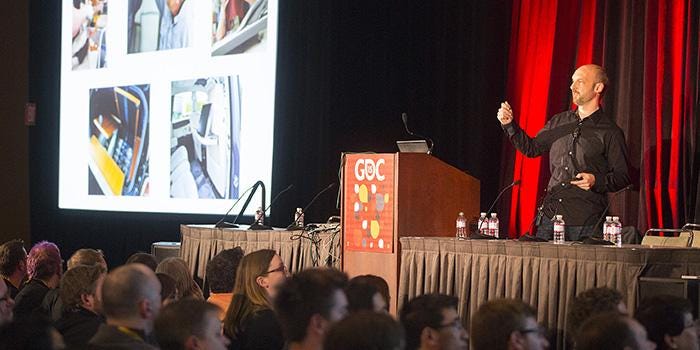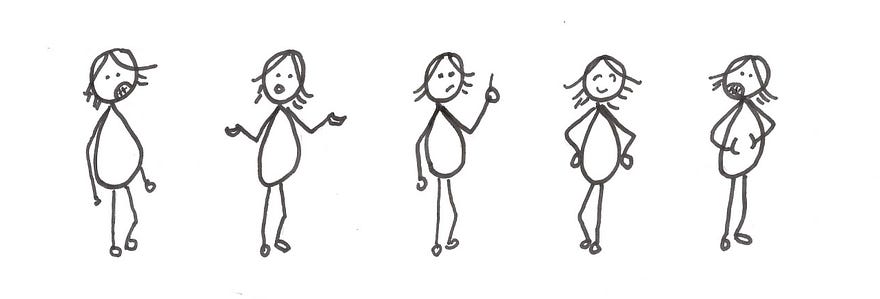This one of a series of essays on speaking. Find more here.
You’ve written a great talk, you’ve made your deck (or not!) and you’ve practiced. But have you considered how you’ll move while speaking?
First, you have to know what you are walking into. You’ll perform in a space that consists of a stage, a room with four walls, a floor full of seats, and a ceiling. All of these elements affect your performance. It is critical to check out the space before you give a talk, preferably 24 hours before.
The stage may be raised or low. Sometimes it’s just an empty bit of floor in front of the chairs for the audience.

It may have nothing but a stand for your laptop or full of tables and chairs.
My talk at GDC was set up for panels, and although I spoke alone, I was trapped behind a long set of tables with a podium in the middle of them (Like Stone Librande in the photo below).

I had checked out the space the day before, I was prepared to be stuck there. I knew I could move to the right of the podium, unblocking more of my body and reducing the distance to my audience, and I had found the blind spots where the audience couldn’t see me.
If you are being videotaped, you also need to find out how much you can move and stay in the camera’s view. I put tape down at the UX Lausanne talk so I knew what the edges of the stage were.
Blocking

Blocking is a theater term. It refers to a plan for how an actor will move during the script. It’s particularly critical for ensemble scenes, but a theater director will make sure every actor knew exactly where they stand and how they’ll move for the entire script. It’s also used in filming movies and tv shows, as shown below.

New presenters often cling to the podium, as if letting go would mean floating off into space.
Intermediate speakers pace. Perhaps they have heard they should get out from behind the podium and are trying to move normally. But let’s be honest, not much is normal about being on stage. With tons of nervous energy and no plans for what to do with it, speakers end up pacing like a caged jaguar. This, understandably, can make the audience anxious.
Experienced presenters walk around purposely, not continuously.
Consider your movement as part of the presentation. If you have three points, pick three places on stage you’ll give each point, and use your transition to a new spot as a subtle message to the audience you are transitioning to a new idea.

You don’t want to be a crazy person, pacing from one end of the stage to the other. Your movements should be purposeful and thought out. I’ve seen some great talks where areas of the stage represent logic and emotion, and the center is the set up for the talk, the balance. Or you can just walk the simple triangle I’ve demarcated above, in order to reach out to different parts of the audience. You don’t have to overthink it, just move occasionally and with purpose.
When you arrive at your point, plant yourself.
Planting
When I say plant, it means stand in a way that keeps you still, without shifting your weight, rocking or leaping into another round of pacing.

I recently taught a course that had a unit on presenting. One of my students planted more comfortably and firmly than anyone I’ve seen. It turns out she had studied ballet, and had a variation of third position she used unconsciously. I’ve adopted this now for my planting. Left foot forward pointing where you are looking, right foot behind it at a slight angle. It’s a stable way to stand and it prohibits rocking as well as pacing, yet allows you to move forward easily when you are ready to make a point.
My previous way to plant was from yoga, and it’s still a go to. It’s called mountain pose. Stand with both feet directly under your hips. If you are rocking or swaying, your feet may be too close or far apart.
Next, sit in. This is a tai chi term for allowing your hips and legs to hold your weight in a stable pose. Often people (especially women) tend to sway back with hips tilted forward pushing the stomach and butt out. This makes you look fat. But if that’s not enough to dissuade you, I can warn you it’s also unsteady.
Tuck hips in and lift up your breast bone straightening your spine. Roll your shoulders back. You can imagine a string at the top of your head pulling you up. Practice this every morning (preferably followed by ten minutes of sun salutations) until you can slide into it naturally.
It’s important to practice standing so you are comfortable. Everyone asks, what should I do with my hands?

Let them fall loosely to your sides, then raise them when you have an appropriate gesture to emphasize a point. Practicing Mountain Pose will make letting your hands just be much easier.
You can see a perfect Mountain Pose plant in this TED talk by John McWhorter. In fact, he plants so completely, he’s almost eerily still.

When rehearsing, if you find yourself pacing, try mountain pose, then move into the modified. See what stabilizes you.
As a side benefit, if you take up yoga/tai chi, it will reduce back issues and curled shoulders brought on by our computer centered lifestyle. A bit of yoga is good for your body as well as your stage poise.
Walking
Unlike actors, most speakers don’t see their stage until the day of the talk (sometimes a few minutes before!) In order to know where to walk and not fall down, you need walk the stage before a talk. Be sure to ask the organizers to let you walk the stage the day before.
Here’s how:

- Start at the podium, if one exists, or at your starting location (which should probably be be Stage Center.)
- Walk back to upstage left, then over to upstage right.
- Walk to downstage right, then over to downstage left.
- If there is an apron, walk it. Return to center. Is there any area you feel awkward? Anything you might trip on? Do you own the stage now?
- Look into the audience. Pick locations to look at audience members. You may be able to see your audience, or the lights might be so bright you can’t. I like a six-point star pattern for making eye contact. i.e I look at the front row center, then back left,, the back right, then back center, then front left, then front right, then sweep across the audience with my eyes. I vary this pattern, but it lets me look at each section of the audience, so they feel like I’m taking to everyone, not just one person.
- Now walk the stage again, practicing looking at different parts of the audience. Try walking your blocking pattern. Does any spot feel awkward? Can you see the audience in all locations? If you can’t see them, they can’t see you…
Show Time!
Day of your talk, remember your body is your instrument. Warm it up.
I recently took an acting class with Kay Kostopoulos at Stanford Continuing Education, and the tools she offers are amazing. If you aren’t in the Bay Area, look for an acting class near you.
This is a small section of her warm up routine.
Shake out the body, jump up and down at least 30 seconds: Then, feel the breath drop into the diaphragm
Shake out the hands: “get rid of them”, feel the tension leave them as you raise them above the head, and energy come into the fingertips.
Stretch out each side: Intercostal muscles. Let the breath expand the ribcage.
Release hands first in the wrists, then elbows, then shoulders, finally let the head release forward.
Let head fall to the left over the shoulder, breathe, make an audible sigh.
Let head fall to the right over the shoulder, breathe, make an audible sigh.
Circle head, and breathe, making vocal sounds of release, “ahhhh”
Shoulders up around the ears, release on a “huh”
Roll the shoulders back, “open hearted” “generous”
Roll the shoulders forward, becoming aware of the space in back of you
Big hip circle with deep vocal release, drop into your lower range (especially women — use that lower range as your power center).
Shake out each leg, extend the toes and pull back, imagining an energy line through the floor and through the ceiling, greater and taller than you are. Filling the space.
Shake out the leg again, feel the floor under you, let the blood flow into the body, compare the “full” leg to the “empty” leg.
Massage the scalp
Blow through the lips
Stretch out the face wide
Scrunch it up small
Massage the forehead, between the eyes, across the bridge of the nose,
Massage the mandibular joint (Jaw)
Stick out the tongue
Roll the tongue, trill the tongue
Blow through the lips
I have a little ritual I like to do before stepping on stage. I reach to my heart as if pulling out a package, and then hand it outward.
 I recite, “It’s not about me, I have a gift to share.”
I recite, “It’s not about me, I have a gift to share.”
It’s a reminder that my talks are not about me looking cool or being judged, but I’m there because I’m excited to share a learning that might help someone.
I follow up this with some Amy Cuddy-style power poses, usually standing like Wonder Woman while I’m being introduced.
Rock the Stage
When I first started to research speaking, I found books on how to make slides.
Looking deeper, I found books on how to make stories.
But what makes a talk special is that it is a human on stage. It’s not just words and pictures. It’s me, here in real life, talking to you, in real life, and hopefully connecting.
That moment on connection is worth preparing for.

This one of a series of essays on speaking. Find more here.